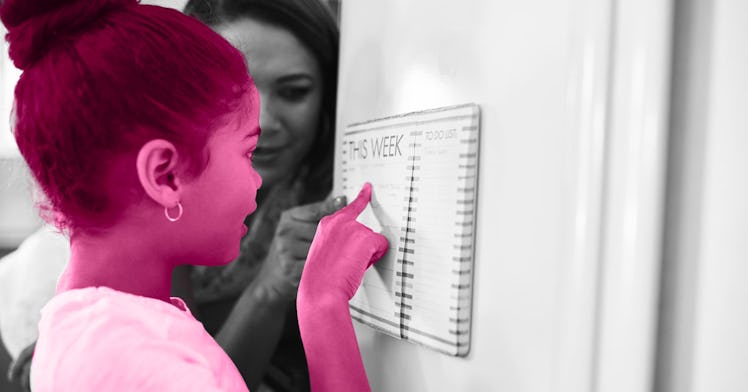The Best Weekly Chore Charts to Help Kids Get Organized in 2021
It's all in the acronym: SSRRR.

While expecting parents may grasp the fact that the moment their child is born, their own needs will give way to their kids’ needs, really nothing can prepare a person for how instant or total that transformation is. One moment, you’re absent-mindedly grabbing a gallon of milk and the next you’re wondering if it has enough calcium to meet your child’s growing needs. Making room for all those shifting needs and responsibilities takes time and tools. Giving kids some of that responsibility through age appropriate chores not only lightens a parent’s load, it helps kids develop a sense of independence, competence, and responsibility. Chore charts are a simple, powerful tool — part time-management hack, part child-development booster, helping kids to make sense of the week while also preparing them for a lifetime of choices and responsibility.
We’ve rounded up some of the best weekly chore charts, including customizable, magnetic, and dry-erase chore charts that come equipped with stickers, stars and other motivating little rewards. Whether you buy a chore chart, download an app, or make your own, the same fundamental rules apply. We spoke to Dr. Amy Nasamran, a licensed child psychologist and the founder of Atlas Psychology, about how to use chore charts as a parenting tool to nurture kids, while also motivating them, giving them a sense of responsibility, teaching them life skills, and inculcating the importance of rules and decision-making.
So what makes a good chore chart? To start with: simplicity.
A Good Chore Chart Should Be Simple
It is important to “start small to build success,” says Dr. Nsamran. “Although it sounds counterintuitive, when there’s a lot to get done, chores can become dreadful and overwhelming for adults and kids alike.” Start your kids out with one or two chores, preferably something that they are familiar with. Kids are motivated to do more when they experience success with smaller tasks. You can add more chores later once they get comfortable with this routine.
A Good Chore Chart Should Be Specific
“Chores like ‘clean up your room’ or ‘keep your desk tidy’ are too vague for children and leave too much room for negotiation,” adds Nsamran. While picking out or adding tasks to chore charts, look for chores that specifically describe what a child should do. Rather than asking your child to clean up their room, specify exactly what you want done, such as making the bed or putting away toys.
A Good Chore Chart Gives Room for Rotation
Dr. Nasamran advises that at least one of the chores on the chart should be one that kids are already doing at least 50 percent of the time. Again, this helps to build motivation and success. It is important for kids to feel like they can be successful at the task so it doesn’t become too daunting. “Kids, like adults, may be prone to avoiding daunting tasks. Including one easy task alongside a more challenging task can help kids build momentum to get started.”
A Good Chore Chart Provides Instant Rewards
When picking our chore charts, look out for ones that allow instant rewards. “Kids thrive off praise and rewards for doing good work. Immediate rewards are more effective for children than waiting until the end of the week or month to be praised or earn a reward,” advises Nasamran. Look for chore charts that allow kids to add a sticker, check off a completed chore, or earn a small privilege immediately after they complete a chore. Don’t forget to communicate what kind of reward you’re offering. Transparency is important.
A Good Chore Chart Teaches Responsibility
As much as it is important to get chores done correctly, it is also important to teach your kids about bigger life lessons associated with each chore, as well as the implications of not adhering to duty. You can decide to add behavioral goals to the chore chart and reward your kids for good behavior as well.
For the use of a chore chart to be successful, it is important that parent keep certain things in mind:
How to Utilize Chore Charts for Kids: Some Helpful Tips
- Create a 1:1 association for the task and the reinforcement. This means that if your kid empties the trash they get one star or sticker. Don’t create a system where kids don’t get credit for what they’ve done, for example setting it up so that they have to empty the trash for 5 days to get one star. In that scenario, they wouldn’t get any credit if they’d done it 4 out of 5 days, and it is always important to celebrate the positives.
- Never take stars away. It can be tempting for parents to threaten to remove stars for negative behavior, but it backfires because it seems arbitrary and decreases motivation to continue.
- Be specific about rewards. Some families will choose not to use rewards, and will instead use the stickers to keep up with who has done what and when. Some families may count the star or sticker as the reward, and some will have stars or stickers represent working toward something tangible. Be specific from the beginning about which method you are adopting so your child knows what to expect.
- Keep data. If you’re using the chart to see who did which chore and when it is helpful to keep some historical data. That means if child A swept the kitchen this week, you have evidence to show that when child B protests that it’s not their turn next week. Charts that have multiple days or weeks can help with this, or you can jot it down somewhere nearby.
Leigh Ellen Watts Magness, Licensed Clinical Social Worker, Registered Play Therapist at Growth Therapy
This article was originally published on